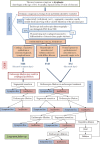Congenital esophageal stenosis: a rare malformation of the foregut
- PMID: 31849372
- PMCID: PMC6892676
- DOI: 10.18999/nagjms.81.4.535
Congenital esophageal stenosis: a rare malformation of the foregut
Abstract
Congenital esophageal stenosis (CES) is a type of esophageal stenosis, and three histological subtypes (tracheobronchial remnants, fibromuscular thickening or fibromuscular stenosis, and membranous webbing or esophageal membrane) are described. Symptoms of CES usually appears with the introduction of the semisolid alimentation. Dysphagia is the most common symptom, but esophageal food impaction, respiratory distress or failure to thrive can be clinical manifestations of CES. Wide spectrum of differential diagnoses leads to delayed definitive diagnosis and appropriate treatment. Depends on hystological subtype of CES, some treatment procedures (dilation or segmental esophageal resection) are recommended, but individually approach is still important in terms of frequency and type of dilation procedures or type of the surgical treatment. Dysphagia can persist after the treatment and a long follow-up period is recommended. In 33% of patients with CES, a different malformations in the digestive system, but also in the other systems, are described.
Keywords: congenital esophageal stenosis; dysphagia; esophageal dilatation; esophageal stricture; infant.
Conflict of interest statement
The authors declare no conflict of interest.
Figures


References
-
- Nihoul-Fékété C, De Backer A, Lortat-Jacob S, Pellerin D. Congenital esophageal stenosis, a review of 20 cases. Pediatr Surg Int. 1987;2:86–92.
-
- Romeo E, Foschia F, de Angelis P, et al. Endoscopic management of congenital esophageal stenosis. J Pediatr Surg. 2011;46(5):838–841. - PubMed
-
- Jones DW, Kunisaki SM, Teitelbaum DH, Spigland NA, Coran AG. Congenital esophageal stenosis: the differential diagnosis and management. Pediatr Surg Int. 2010;26:547–551. - PubMed
-
- Bluestone CD, Kerry R, Sieber WK. Congenital esophageal stenosis. Laryngoscope. 1969;79(6):1095–1103. - PubMed
Publication types
MeSH terms
LinkOut - more resources
Full Text Sources
Medical
